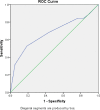Dehydroepiandrostenedione sulphate (DHEAS) levels predict high risk of rheumatoid arthritis (RA) in subclinical hypothyroidism
- PMID: 33592022
- PMCID: PMC7886134
- DOI: 10.1371/journal.pone.0246195
Dehydroepiandrostenedione sulphate (DHEAS) levels predict high risk of rheumatoid arthritis (RA) in subclinical hypothyroidism
Abstract
Introduction: The presence of rheumatism is well recognized in primary hypothyroidism. Dehydroepiandrstenedione sulphate (DHEAS) is associated with rheumatological diseases like rheumatoid arthritis (RA) and systemic lupus erythematosus (SLE). This study aims to explore relationship between joint pains and DHEAS levels in primary hypothyroidism.
Methods: Retrospective study of 78 subjects with subclinical hypothyroidism, with TSH within reference range. The joint pains were evaluated by European Union League against rheumatism (EULAR-CSA) score and compared with serum DHEAS, RA factor, Anti-TPO antibody, highly sensitive C-recative protein (hsCRP), vitamin D levels.
Result: DHEAS levels <43.6 mcg/dl significantly predicted clinical features of pre RA as assessed by EULAR CSA criteria with acceptable specificity (82%). EULAR CSA score is fairly valid in assessing imminent RA in primary hypothyroidism.
Conclusion: Lower DHEAS predicts clinical features of imminent RA in subjects with primary hypothyroidism. This is akin to low DHEAS seen in many rheumatological disease with possibly similar mechanism. Another possibility is low DHEAS alters hepato-hypothalamo pituitary adrenal axis in presense of cytokines and induces a hitherto unrecognized state of pre rheumatoid arthritis like syndrome. Future studies on primary hypothyroidism should focus on role of lower DHEAS levels in inducing symptoms of fatigue and joint pains.
Conflict of interest statement
The authors have declared that no competing interests exist.
Figures




Similar articles
-
Renal clearance and daily excretion of cortisol and adrenal androgens in patients with rheumatoid arthritis and systemic lupus erythematosus.Ann Rheum Dis. 2004 Aug;63(8):961-8. doi: 10.1136/ard.2003.014274. Ann Rheum Dis. 2004. PMID: 15249323 Free PMC article.
-
Perturbations of hypothalamic-pituitary-gonadal axis and adrenal androgen functions in rheumatoid arthritis: an odyssey of hormonal relationships to the disease.Ann N Y Acad Sci. 1999 Jun 22;876:53-62; discussion 62-3. doi: 10.1111/j.1749-6632.1999.tb07622.x. Ann N Y Acad Sci. 1999. PMID: 10415593 Review.
-
Inadequately low serum levels of steroid hormones in relation to interleukin-6 and tumor necrosis factor in untreated patients with early rheumatoid arthritis and reactive arthritis.Arthritis Rheum. 2002 Mar;46(3):654-62. doi: 10.1002/art.10177. Arthritis Rheum. 2002. PMID: 11920401
-
Serum levels of pregnenolone and 17-hydroxypregnenolone in patients with rheumatoid arthritis and systemic lupus erythematosus: relation to other adrenal hormones.J Rheumatol. 2003 Feb;30(2):269-75. J Rheumatol. 2003. PMID: 12563679
-
Do women with premenopausal-onset rheumatoid arthritis have relative insufficiency or imbalance of adrenocortical steroids?Ann N Y Acad Sci. 2014 May;1317:7-16. doi: 10.1111/nyas.12435. Epub 2014 Apr 22. Ann N Y Acad Sci. 2014. PMID: 24754504 Review.
Cited by
-
Musculoskeletal adverse events induced by immune checkpoint inhibitors: a large-scale pharmacovigilance study.Front Pharmacol. 2023 Oct 10;14:1199031. doi: 10.3389/fphar.2023.1199031. eCollection 2023. Front Pharmacol. 2023. PMID: 37881181 Free PMC article.
References
-
- Emamifar A, Hangaard J, Jensen Hansen IM. Thyroid disorders in patients with newly diagnosed rheumatoid arthritis is associated with poor initial treatment response evaluated by disease activity score in 28 joints-C-reactive protein (DAS28-CRP): An observational cohort study. Medicine (Baltimore). 2017;96(43): e8357 10.1097/MD.0000000000008357 - DOI - PMC - PubMed
-
- Tagawa N, Tamanaka J, Fujinami A, Kobayashi Y, Takano T, Fukata S, et al. Serum dehydroepiandrosterone, dehydroepiandrosterone sulfate, and pregnenolone sulfate concentrations in patients with hyperthyroidism and hypothyroidism. Clin Chem 2000. April;46(4):523–8. - PubMed
MeSH terms
Substances
LinkOut - more resources
Full Text Sources
Other Literature Sources
Medical

